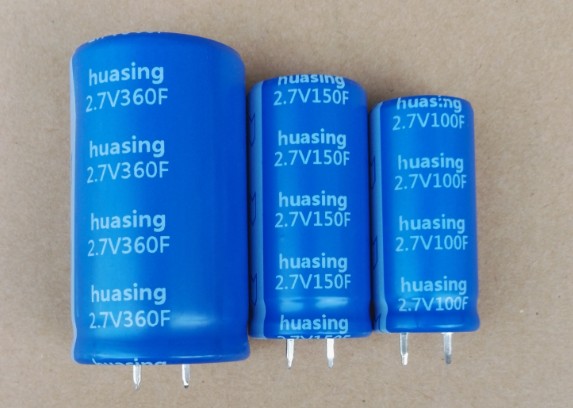
2.3V Snap In/Solder Terminal Supercapacitor
- Series: SSN
- Working Voltage Range: 2.3V
- Capacitance Range: 100F~800F
- Working Temperature: -25~+70°C
- Load Life: 500,000 cycles at 25°C
- Application: Consumer electronic, Portable power tools, DC-DC converters
 (※Click this button to inquiry)
(※Click this button to inquiry)
Download Product Manual (PDF file) Send an E-mail to us!
Snap In/Solder Terminal Supercapacitor 2.3V electrical double-layer capacitor
Feature:
● High energy density, High power
● Long cyclelife
● Maintenance-free
Application:
● Electrictool, Consumer electronics
● Solar streetlight
● Energy recovery
● Main power, Back up power
| Rated Voltage (V) |
øDxL (mm) |
ESR 1kHz mΩ |
ESR (mΩ) |
Maximum Endurance Current(A) |
Maximum Peak Current(A) |
Maximum Leakage Current (72hrs/mA) |
Power Density (W/kg) |
Maximum Energy (W.h) |
Energy Density (Wh/kg) |
Part number |
| 2.3V 220F | 22x45 | 15 | 27 | 4.29 | 36.46 | 0.600 | 931 | 0.166 | 6.40 | SSN2R3M227SS2245 |
| 2.3V 300F | 22x45 | 14 | 25 | 5.8 | 40.59 | 0.700 | 907 | 0.2204 | 7.87 | SSN2R3M307SS2245 |
| 2.3V 300F | 22x50 | 13 | 23 | 5.9 | 43.67 | 0.700 | 863 | 0.2204 | 6.89 | SSN2R3M307SS2250 |
| 2.3V 600F | 30x60 | 12 | 21.6 | 11.7 | 49.43 | 1.000 | 487 | 0.4408 | 7.3 | SSN2R3M607SS3060 |
| 2.3V 800F | 35x60 | 10 | 18 | 15.6 | 59.74 | 1.500 | 468 | 0.5878 | 7.8 | SSN2R3M807SS3560 |

Datasheet(PDF) of 2.3V Snap In/Solder Terminal Supercapacitor, please contact us.
Send us the Part Number, for example, SRH2R7M506RS1840.
Handling Precautions and Guidelines:
For safety application, please contact us directly for any technical specifications, handling precautions and guidelines critical to application.
1.1 Precautions
(1) Prohibition of disassembly
The disassembling may generate internal short circuit in the cell, which may cause gassing, leakage, explosion, or other problems.
Electrolyte is harmful: In case the electrolyte come into contact with the skin, or eyes, physicians shall flush the electrolyte immediately with fresh
water and medical advice is to be sought.
(2) Prohibition of dumping of cells into fire
These may cause explosion of the cells, which is very dangerous and is prohibited.
(3) Prohibition of cells immersion into liquid
The cells shall never be soaked with liquids such as water, seawater, drinks such as juices, coffee or others.
(4) Prohibition of use of damaged cells
The cells might be damaged during shipping by shock. If any abnormal features of the cells are found such as damages in the cell package, smelling of an electrolyte, an electrolyte leakage and others, the cells shall never be used any more.
The Cells with a smell of the electrolyte or a leakage shall be placed away from fire to avoid firing or explosion
1.2 Handling Guidelines
(1) It is not suitable that cell is used under such conditions: AC circuit and wave filtering.
(2) Work voltage of cell should not exceed Max. work voltage of cell during using. Otherwise, will shorten shelf life,even cause swelling, leakage or crack.
(3) Please check the polarity before using. If working under reverse polarity, cell will not only shorten shelf life, but also heavy damage, such as swelling, electrolyte leakage etc.
(4) Environment
Work temperature will have an influence on shelf life of cell. As usual, higher work temperature will shorten shelf life. So, it is better that cell works under as possible as low environmental temperature.Work temperature of cell should consider internal work temperature in the unit and temperature rise when cellworks.
(5) IR drop
When main power sources shut down, cell will change into work mode from failure mode, at the same time, OCV will decrease due to IR drop. So please choose proper product type according to impedance specified in product datasheet and applied current.
(6) Cells in series connection
When cells in series connection for higher work voltage, it should be assured that work voltage of any single cell must not exceed Max. work voltage of single cell, otherwise, will shorten shelf life, even cause swelling, leakage or crack.
(7) Soldering
Heat shock will decrease electric performance of cell, even cause swelling, leakage or crack. Soldering temperature should not exceed 230℃, soldering time should not exceed 5s.
(8) Please don’t use reflow soldering of infrared heating and air heating.
There are some other products you may be intersted in , please click to know about the details.
Electric Double Layer Capacitor (EDLC) 5.5V Plastic Shell Module Ultracapacitors 7.5V Radial Leads 3 Series Module Ultracapacitors 5.5V Radial Leads Ultracapacitors PET Tube Threaded/Weldable High Capacitance Ultracapacitors
 Tel:86 0513 65085106 Fax:86 0513 81164838
Tel:86 0513 65085106 Fax:86 0513 81164838 
